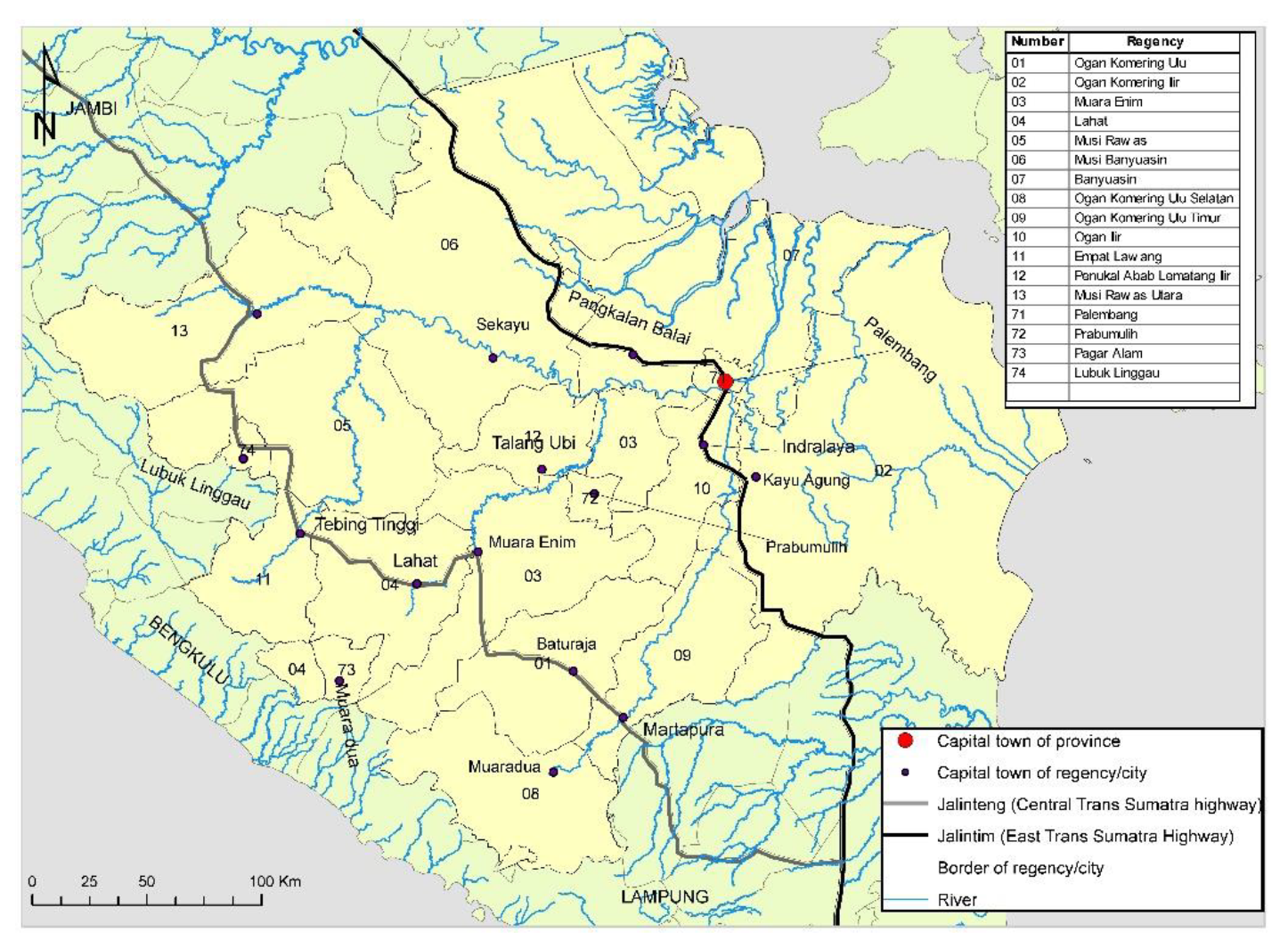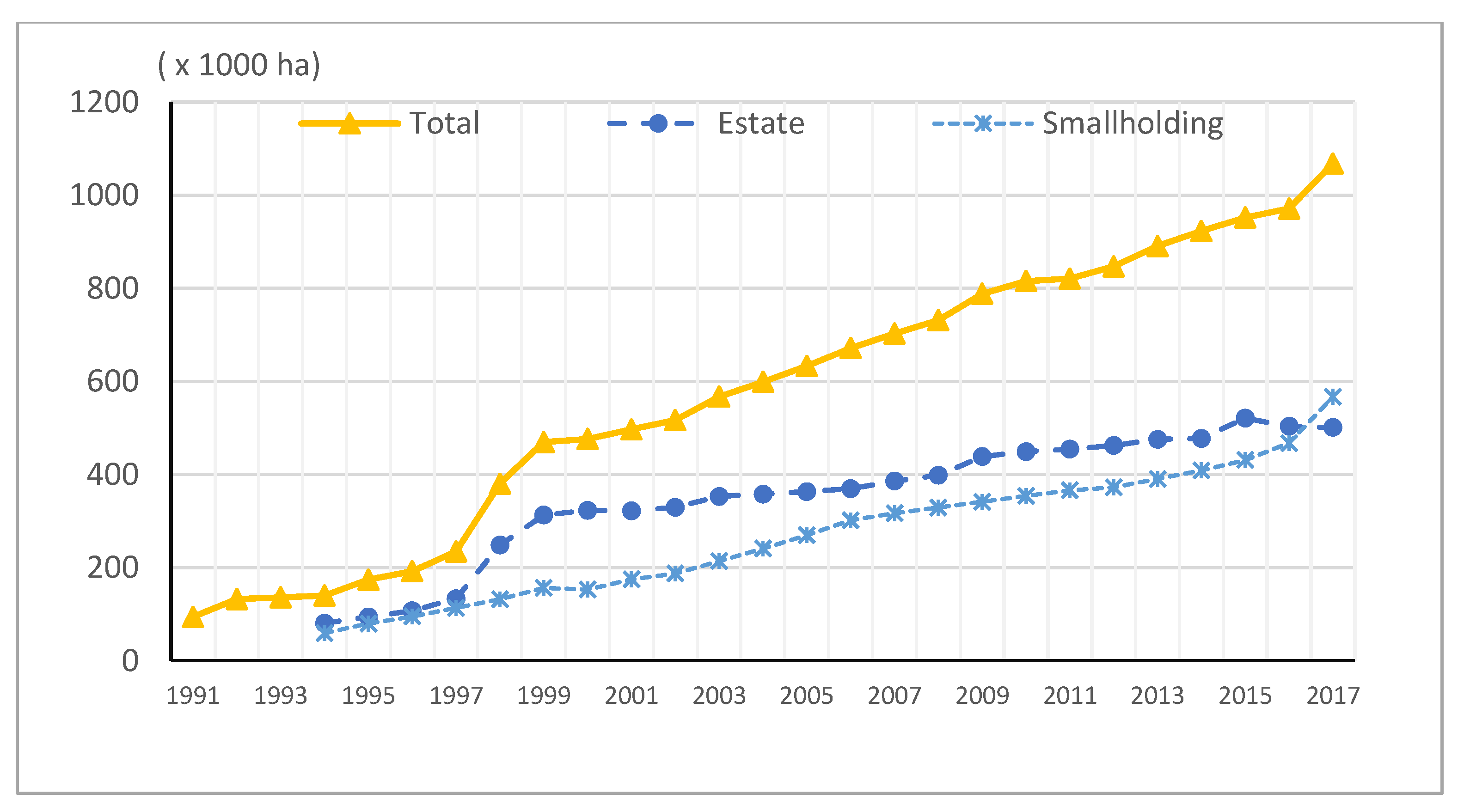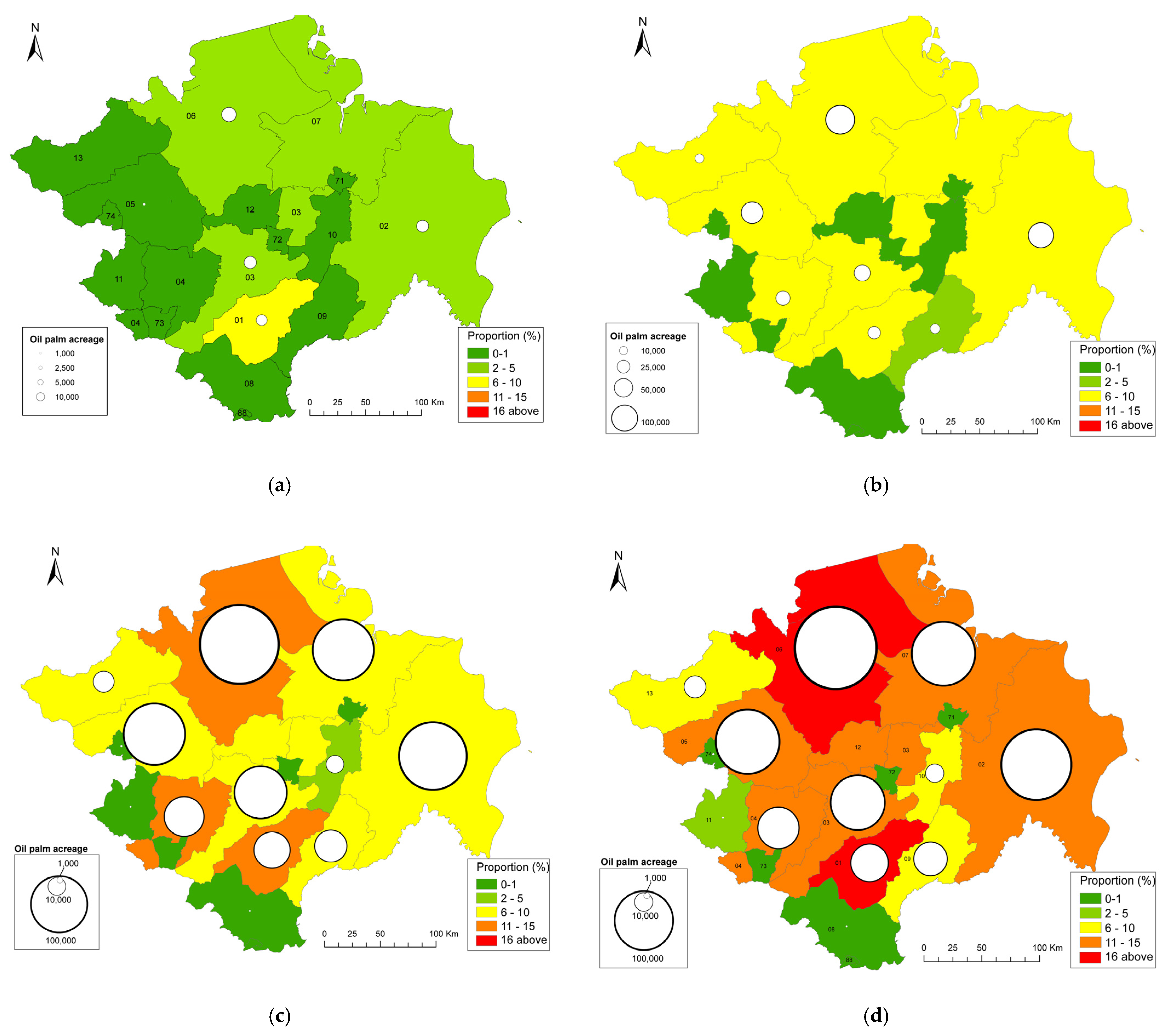Oil Palm Land Use Change and Rice Sustainability in South Sumatra, Indonesia
Abstract
:1. Introduction
2. Data and Methods
2.1. General Condition of South Sumatra
2.2. Data Collection and Analysis
3. Results
3.1. The Trend of Oil Palm Land Use in South Sumatra
3.2. Spatial Distribution of Oil Palm
3.3. Rice Sustainability in South Sumatra
3.3.1. Rice Land-Use Change
3.3.2. Rice Productivity
4. Discussion
5. Conclusions
Author Contributions
Funding
Institutional Review Board Statement
Informed Consent Statement
Data Availability Statement
Conflicts of Interest
References
- FAO. A Regional Rice Strategy for Sustainable Food Security in Asia and The Pacific; Food and Agriculture Organization of the United Nations Regional Office for Asia and The Pacific: Bangkok, Thailand, 2014. [Google Scholar]
- Suryana, A. National Rice Performance. In Rice Policy in Asia. Regional Meeting in Bangkok; Dewan Ketahanan Nasional: Jakarta, Indonesia, 2002. [Google Scholar]
- FAO. Production Quantities/Yield of Rice, Paddy in Indonesia 1994–2019. 2020. Available online: http://www.fao.org/faostat/en/#data/QC/visualize (accessed on 24 May 2021).
- BPS. Impor Beras Menurut Negara Asal Utama, 2000–2020, BPS Indonesia. 2020. Available online: https://www.bps.go.id/statictable/2014/09/08/1043/impor-beras-menurut-negara-asal-utama- (accessed on 24 May 2021).
- BPS. Indonesia Population Projection 2015–2045; BPS: Jakarta, Indonesia, 2018. [Google Scholar]
- BPS. Statistical Yearbook of Indonesia 2019; BPS: Jakarta, Indonesia, 2018. [Google Scholar]
- Ministry of Agriculture. Tree Crop Estate Statistics of Indonesia 2017–2019; Directorate General of Plantation, Ministry of Agriculture RI: Jakarta, Indonesia, 2019. [Google Scholar]
- Ministry of Agriculture. Statistics of National Leading Estate Crops Commodity 2019–2021; Directorate General of Plantation, Ministry of Agriculture RI: Jakarta, Indonesia, 2020. [Google Scholar]
- Gunarso, P.; Hartoyo, M.E.; Agus, F.; Killeen, T.J. Oil palm and land use change in Indonesia, Malaysia and Papua New Guinea. In Reports from the Technical Panels of the 2nd Greenhouse Gas Working Group of the Roundtable on Sustainable Palm Oil (RSPO); RSPO: Geneva, Switzerland, 2013. [Google Scholar]
- Chrisendo, D.; Krishna, V.V.; Maize, I.; Qaim, M. Land-Use Changes, Nutrition, and Gender Roles in Indonesian Farm Households. For. Policy Econ. 2020, 118, 102245. [Google Scholar] [CrossRef]
- Bou Dib, J.; Alamsyah, M.; Matin, Q. Land-use change and income inequality in rural Indonesia Forest Policy and Economics Land-use change and income inequality in rural Indonesia. For. Policy Econ. 2018, 94, 55–66. [Google Scholar] [CrossRef]
- Bou Dib, J.; Krishna, V.V.; Qaim, M. Land-use change and livelihoods of non-farm households: The role of income from employment in oil palm and rubber in rural Indonesia. Land Use Policy 2018, 76, 828–838. [Google Scholar] [CrossRef] [Green Version]
- Euler, M.; Krishna, V.; Schwarze, S.; Siregar, H.; Qaim, M. Oil Palm Adoption, Household Welfare, and Nutrition Among Smallhoder Farmers in Indonesia. World Dev. 2017, 93, 219–235. [Google Scholar] [CrossRef] [Green Version]
- Astuti, U.P.; Wahyu, W.; Andi, I. Faktor Yang Mempengarhui Alih Fungsi Lahan Pangan Menjadi Kelapa Sawit di Bengkulu: Kasus Petani di Desa Kungkai Baru. In Urgensi dan Strategi Pengendalian Alih Fungsi Lahan Pertanian; Fakultas Pertanian Universitas Bengkulu: Bengkulu, Indonesia, 2011; pp. 189–195. [Google Scholar]
- Daulay, A.R.; Putri, E.I.K.; Barus, B.; Noorachmat, B.P. Analysis of Factors Affecting Lowland Conversion into Palm Oil Plantation in East Tanjung Jabung Regency. Anal. Kebijak. Pertan. 2016, 14, 1–15. [Google Scholar]
- Alridiwirsah. Konversi Lahan Sawah Menjadi Kelapa Sawit Dan Dampak Terhadap Ketersediaan Beras Di Kabupaten Labuhanbatu Utara. Agrium 2013, 18, 169–174. [Google Scholar]
- Prabowo, D.; Maryudi, A.; Imron, M.A. Forest Policy and Economics Conversion of forests into oil palm plantations in West Kalimantan, Indonesia: Insights from actors’ power and its dynamics. For. Policy Econ. 2017, 78, 32–39. [Google Scholar] [CrossRef]
- Sayer, J.; Ghazoul, J.; Nelson, P.N.; Klintuni, A. Oil palm expansion transforms tropical landscapes and livelihoods. Glob. Food Secur. 2012, 1, 114–119. [Google Scholar] [CrossRef]
- Feintrenie, L.; Chong, W.K.; Levang, P. Why do Farmers Prefer Oil Palm ? Lessons Learnt from Bungo District, Indonesia. Small-Scale For. 2010, 9, 379–396. [Google Scholar] [CrossRef]
- Krishna, V.; Euler, M.; Siregar, H.; Qoim, M. Farmer heterogeneity and differential livelihood impacts of oil palm expansion in Sumatra, Indonesia. In Proceedings of the 2016 Agricultural and Applied Economics Association (AAEA) Annual Meeting, Boston, MA, USA, 31 July–2 August 2016. [Google Scholar]
- Pretty, J.N. Regenerating Agriculture: Policies and Practice for Sustainability and Self-Reliance; Joseph Henry Press: Washington, DC, USA, 1995. [Google Scholar]
- Zhen, L.; Routray, J.K. Operational Indicators for Measuring Agricultural Sustainability in Operational Indicators for Measuring Agricultural Sustainability in Developing Countries. Environ. Manag. 2003, 32, 34–46. [Google Scholar] [CrossRef] [Green Version]
- Smith, C.S.; Mcdonald, G.T. Assessing the sustainability of agriculture at the planning stage. J. Environ. Manag. 1998, 52, 15–37. [Google Scholar] [CrossRef] [Green Version]
- Lebacq, T.; Baret, P.V.; Stilmant, D. Sustainability indicators for livestock farming: A review. Agron. Sustain. Dev. 2013, 33, 311–327. [Google Scholar] [CrossRef]
- Ripoll-Bosch, R.; Díez-Unquera, B.; Ruiz, R.; Villalba, D.; Molina, E.; Joy, M.; Olaizola, A.; Bernués, A. An integrated sustainability assessment of mediterranean sheep farms with different degrees of intensification. Agric. Syst. 2012, 105, 46–56. [Google Scholar] [CrossRef]
- Rasul, G.; Thapa, G.B. Sustainability of ecological and conventional agricultural systems in Bangladesh: An assessment based on environmental, economic and social perspectives. Agric. Syst. 2004, 79, 327–351. [Google Scholar] [CrossRef]
- Gomez-Limon, V.; Riesgo, J.A. Alternative approaches to the construction of a composite indicator of agricultural sustainability: An application to irrigated agriculture in the Duero basin in Spain. J. Environ. Manag. 2009, 90, 3345–3362. [Google Scholar] [CrossRef]
- Ministry of Agiculture. Pencarian Data Dengan Keluaran Berdasar Komoditas. Available online: https://aplikasi2.pertanian.go.id/bdsp/id/komoditas (accessed on 31 March 2022).
- Bakir, L.H. Kinerja Perusahaan Inti Rakyat Kelapa Sawit di Sumatera Selatan: Analisis Kemitraan dan Ekonomi Rumahtangga Petani; Institute Pertanian Bogor: Bogor, Indonesia, 2007. [Google Scholar]
- Ngadi; Nagata, J. Development of the Oil Palm Plantation Sector in South Sumatra Province. Komaba Stud. Hum. Geogr. 2020, 23, 1–12. [Google Scholar]
- Syafa’at, N.; Friyatno, S.; Mardianto dan Suyadi, S. Kinerja nilai tambah dan produksi sektor pertanian, 2000–2003. Analisis Kebijakan Pertanian 2013, 2, 1–16. [Google Scholar]
- Yudanto, N.; Santoso, M.S. Dampak krisis moneter terhadap sektor riil. Buletin Ekonomi Moneter dan Perbankan 1998, 1, 131–158. [Google Scholar] [CrossRef]
- Krishna, V.; Euler, V.; Siregar, H.; Qaim, M. Differential livelihood impacts of oil palm expansion in Indonesia. Agric. Econ. 2017, 48, 639–653. [Google Scholar] [CrossRef]
- Rist, L.; Feintrenie, L.; Levang, P. The livelihood impacts of oil palm: Smallholders in Indonesia. Biodivers. Conserv. 2010, 19, 1009–1024. [Google Scholar] [CrossRef]
- Alwarritzi, W.; Nanseki, T.; Chomei, Y. Impact of Oil Palm Expansion on Farmers’ Crop Income and Poverty Reduction in Indonesia: An Application of Propensity Score Matching. J. Agric. Sci. 2016, 8, 119–131. [Google Scholar] [CrossRef]
- BPS. Executive Summary the Cost Structure of Strategic Estate Crop Commodities: 2014 Results of Estate Crops Cultivation Household Survey, 2014; BPS Indonesia: Jakarta, Indonesia, 2016. [Google Scholar]
- BPS South Sumatra. Analisis Rumah Tangga Usaha Perkebunan di Sumatera Selatan: Hasil Sensus Pertanian 2013; BPS South Sumatra: Palembang, Indonesia, 2016. [Google Scholar]
- Nagata, J.; Arai, S.W. Evolutionary change in the palm oil plantation sector in Riau Province, Sumatra. In The Palm Oil Controversy in Southeast Asia: A Transnational Perspective; ISEAS Publishing Institute of Southeast Asian Studies: Singapore, 2013. [Google Scholar]
- BPS South Sumatra. Province South Sumatra Figure ST2013—Sub Sector Results of Paddy Cultivation Household Survey; BPS South Sumatra: Palembang, Indonesia, 2014. [Google Scholar]
- Susanto, R.H.; Mulyana, A.; Umar Harun, M.; Irsan, C.; Zaidan; Agus Suwignyo, R.; Nancy, C.; Sabarudin; Siswanto, A.; Husnah; et al. Master Plan Lumbung Pangan Sumatera Selatan; Universitas Sriwijaya: Palembang, Indonesia, 2005. [Google Scholar]
- Daryanto, A. Indonesia’s Crisis and the Agricultural Sector: The Relevance of Agricultural Demand-Led Industrialisation; UNE Asia Centre: Bangkok, Thailand, 1999. [Google Scholar]
- South Sumatra Plantation Service. Plantation Statistics; South Sumatra Plantation Services: Palembang, Indonesia, 2016. [Google Scholar]
- East OKU Government, “Pertanian”. 2021. Available online: http://www.okutimurkab.go.id/pertanian.html (accessed on 28 February 2022).
- BPS South Sumatra. Analysis of Paddy Productivity in South Sumatra; BPS South Sumatra: Palembang, Indonesia, 2020. [Google Scholar]
- Girsang, S.S.; Raharjo, B. Factors affecting rice yield productivity in tidal swamp of South Sumatra Factors affecting rice yield productivity in tidal swamp of South Sumatra. In Proceedings of the 1st International Conference on Sustainable Tropical Land Management, Bogor, Indonesia, 16–18 September 2020; p. 12. [Google Scholar]
- Kementerian PPN/Bappenas. Analysis of the Development of South Sumatra Province Series; Kementerian PPN/Bappenas: Jakarta. 2015. Available online: https://simreg.bappenas.go.id/assets/temaalus/document/Publikasi/DokPub/Analisis%20Provinsi%20Sumatera%20Selatan%202015ok.pdf (accessed on 22 February 2022).
- Maryana, Y.E.; Suprihatin, A.; Raharjo, B.; Ratmani, N.P.S. Increasing Paddy Productivity in Tidal Low Lands of South Sumatra through the Implementation of New Superior Varieties and Amator. J. Suboptimal Lands 2022, 11, 59–66. [Google Scholar] [CrossRef]






| District | Rice Area (ha) | Oil Palm Area (ha) | Rice/Oil Palm Land Ratio | |||||
|---|---|---|---|---|---|---|---|---|
| 2011 | 2017 | Growth (%/Year) | 2011 | 2017 | Growth (%/Year) | 2011 | 2017 | |
| Banyuasin | 190,341 | 256,194 | 5.8 | 117,656 | 186,741 | 9.8 | 1.6 | 1.4 |
| East OKU | 130,288 | 173,588 | 5.5 | 13,948 | 28,098 | 16.9 | 9.3 | 6.2 |
| Ogan Komering Ilir | 129,799 | 165,347 | 4.6 | 143,820 | 213,005 | 8.0 | 0.9 | 0.8 |
| Musi Banyu Asin | 63,397 | 78,164 | 3.9 | 195,312 | 330,784 | 11.6 | 0.3 | 0.2 |
| Musi Rawas * | 57,512 | 76,630 | 5.5 | 132,786 | 151,812 | 2.4 | 0.4 | 0.5 |
| Ogan Ilir | 46,626 | 47,839 | 0.4 | 9701 | 13,034 | 5.7 | 4.8 | 3.7 |
| Lahat | 34,802 | 44,007 | 4.4 | 50,165 | 46,622 | −1.2 | 0.7 | 0.9 |
| Empat Lawang | 29,007 | 25,055 | −2.3 | 280 | 7045 | 402.7 | 103.6 | 3.6 |
| Muara Enim ** | 44,971 | 53,543 | 3.2 | 106,513 | 106,968 | 0.1 | 0.4 | 0.5 |
| South OKU | 26,216 | 45,297 | 12.1 | 123 | 3526 | 461.1 | 213.1 | 12.8 |
| OKU | 14,054 | 12,849 | −1.4 | 40,952 | 43,900 | 1.2 | 0.3 | 0.3 |
| Pagar Alam | 8312 | 9112 | 1.6 | 0 | 0 | 0 | - | - |
| Lubuk Linggau | 4276 | 6043 | 6.9 | 128 | 430 | 39.3 | 33.4 | 14.1 |
| Palembang | 4643 | 5687 | 3.7 | 0 | 0 | 0 | - | - |
| Prabumulih | 576 | 618 | 1.2 | 874 | 0 | −16.7 | 0.7 | - |
| Total | 784,820 | 999,973 | 4.6 | 812,258 | 1,131,965 | 6.6 | 1.0 | 0.9 |
Publisher’s Note: MDPI stays neutral with regard to jurisdictional claims in published maps and institutional affiliations. |
© 2022 by the authors. Licensee MDPI, Basel, Switzerland. This article is an open access article distributed under the terms and conditions of the Creative Commons Attribution (CC BY) license (https://creativecommons.org/licenses/by/4.0/).
Share and Cite
Ngadi, N.; Nagata, J. Oil Palm Land Use Change and Rice Sustainability in South Sumatra, Indonesia. Land 2022, 11, 669. https://doi.org/10.3390/land11050669
Ngadi N, Nagata J. Oil Palm Land Use Change and Rice Sustainability in South Sumatra, Indonesia. Land. 2022; 11(5):669. https://doi.org/10.3390/land11050669
Chicago/Turabian StyleNgadi, Ngadi, and Junji Nagata. 2022. "Oil Palm Land Use Change and Rice Sustainability in South Sumatra, Indonesia" Land 11, no. 5: 669. https://doi.org/10.3390/land11050669
APA StyleNgadi, N., & Nagata, J. (2022). Oil Palm Land Use Change and Rice Sustainability in South Sumatra, Indonesia. Land, 11(5), 669. https://doi.org/10.3390/land11050669






